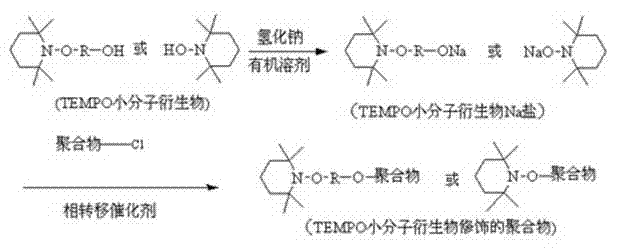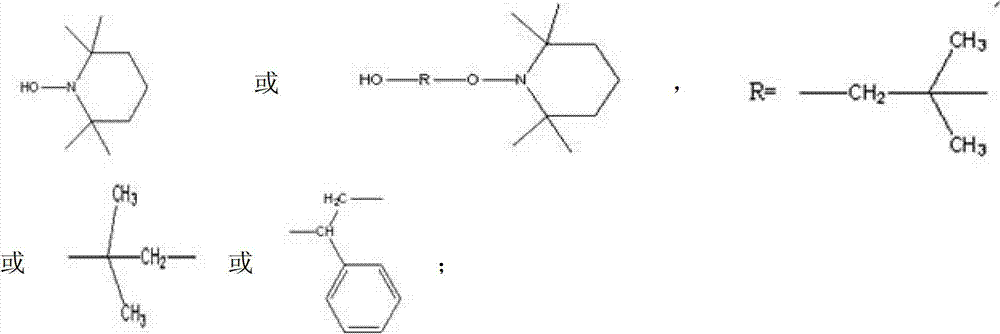Thermal self-repairing polymer material, and preparation and repairing methods thereof
A polymer material and polymer technology, applied in the field of thermal self-healing polymer materials and their preparation and repair, can solve the problems of high repair process conditions, high repair cost, poor repair effect of multiple damages, etc., to achieve repair The effect of short time, high repair ability and simple material structure
- Summary
- Abstract
- Description
- Claims
- Application Information
AI Technical Summary
Problems solved by technology
Method used
Image
Examples
Embodiment 1
[0036] Synthesis of 1-hydroxy-2,2,6,6-tetramethylpiperidine (TEMPO-H) modified poly-p-chloromethylstyrene (PCMS-TEMPO).
[0037]Add a magnetic stirrer in a 250ml three-neck flask, pre-flow argon for 10min, then weigh 2.0 g of sodium hydride (50.0mmol, 60% dispersed in mineral oil) and add it to the flask, then add 20ml of anhydrous tetrahydrofuran to it, and start the electromagnetic Stir to obtain a suspension. Weigh TEMPO-H (6.0g, 38.2mmol) and dissolve it in 30ml of anhydrous tetrahydrofuran, add the solution dropwise to the above suspension at room temperature, and finish dropping within 20min. Afterwards, the reaction mixture was allowed to react at room temperature for about 1.5 h until no bubbles were generated. Then the weighed poly-p-chloromethylstyrene (3.3g) and the phase transfer catalyst 18-crown-6 (0.28g, 1.05mmol) were quickly added to the flask, and the argon gas was continued for 10min, and then the reaction flask was Seal and allow the reaction to continue ...
Embodiment 2
[0038] Example 2 Synthesis of 4-hydroxy-1-(1-phenyl-ethoxy)-2,2,6,6-tetramethylpiperidine-modified poly-p-chloromethylstyrene (PCMS-TEMPO-EOPh).
[0039] Add a magnetic stirrer in a 250ml three-necked flask, pre-pass argon for 10min, then weigh 1.20g of sodium hydride (30.0mmol, 60% dispersed in mineral oil) and add it to the flask, then add 20ml of anhydrous tetrahydrofuran to it, and start the electromagnetic Stir to obtain a suspension. Weigh 4-hydroxy-1-(1-phenyl-ethoxy)-2,2,6,6-tetramethylpiperidine (HO-TEMPO-EOPh) (5.0g, 18.0mmol) and dissolve it in 30ml In water tetrahydrofuran, the solution was added dropwise to the above suspension at room temperature, and the drop was completed within 20 minutes. Afterwards, the reaction mixture was allowed to react at room temperature for about 1.5 h until no bubbles were generated. Then the weighed poly-p-chloromethylstyrene (3.3g) and the phase transfer catalyst 18-crown-6 (0.20g, 0.75mmol) were quickly added to the flask, and...
Embodiment 3
[0040] Example 3 Preparation of thermal self-healing polymer materials.
[0041] Weigh 0.10g PCMS-TEMPO and 0.10g PCMS-TEMPO-EOPh, then add 10ml of toluene solvent, after the polymer is completely dissolved into a transparent solution, cast the solution directly into a glass mold, and place it at room temperature to make the solvent Naturally volatilize to form a film, and then place it in a vacuum oven at 40°C to completely remove the solvent to obtain a thermal self-healing polymer material.
PUM
 Login to View More
Login to View More Abstract
Description
Claims
Application Information
 Login to View More
Login to View More - R&D
- Intellectual Property
- Life Sciences
- Materials
- Tech Scout
- Unparalleled Data Quality
- Higher Quality Content
- 60% Fewer Hallucinations
Browse by: Latest US Patents, China's latest patents, Technical Efficacy Thesaurus, Application Domain, Technology Topic, Popular Technical Reports.
© 2025 PatSnap. All rights reserved.Legal|Privacy policy|Modern Slavery Act Transparency Statement|Sitemap|About US| Contact US: help@patsnap.com



